|
The
|
THE BURGENLAND BUNCH NEWS - No. 229 February 28, 2013, © 2013 by The Burgenland Bunch All rights reserved. Permission to copy excerpts granted if credit is provided. Editor: Thomas Steichen (email: tj.steichen@comcast.net) Our 17th Year. The Burgenland Bunch Newsletter is issued monthly online. It was founded by Gerald Berghold (who retired Summer 2008 and died in August 2008). |
Current Status Of The BB: * Members: 2132 * Surname Entries: 7134 * Query Board Entries: 5090 * Staff Members: 17 |
This newsletter concerns: 1) THE PRESIDENT'S CORNER 2) CHRISTINE REMEMBERS… (by Christine Pöltl Rubba) 3) HOUSE VULGO NAMES & NiT NICKNAMES (by Jack Fritz) 4) US VITAL RECORDS IN BURGENLAND REGISTRIES 5) AN "UNREADABLE" BIRTH LOCATION 6) HISTORICAL BB NEWSLETTER ARTICLES: FOOD IN PRE-EMIGRATION BURGENLAND 7) ETHNIC EVENTS 8) BURGENLAND EMIGRANT OBITUARIES (courtesy of Bob Strauch) |
1) THE PRESIDENT'S CORNER (by Tom Steichen)  Concerning
this newsletter, after the Bits and Pieces below in my
President's Corner, we get down to full length articles starting with one by Canadian
BB Member Christine Pöltl Rubba, who was born in Burgenland. I asked her about
her life in Burgenland and she responded with a two-part article, Christine Remembers...
(part 2 is next month). BB Member Jack Fritz provides our second
article, as he tells us about Neumarkt im Tauchental House Vulgo Names & Nicknames.
The last two articles are joint staff contributions with the first being motivated by
Joe Jarfas, who proposed that the topic of US Vital Records In Burgenland
Registries might be of interest to the membership. The second of these two came out of
the staff's attempt to assist a potential new member with An "Unreadable" Birth Location.
After some effort, it was no longer unreadable... and we lost our potential member! Concerning
this newsletter, after the Bits and Pieces below in my
President's Corner, we get down to full length articles starting with one by Canadian
BB Member Christine Pöltl Rubba, who was born in Burgenland. I asked her about
her life in Burgenland and she responded with a two-part article, Christine Remembers...
(part 2 is next month). BB Member Jack Fritz provides our second
article, as he tells us about Neumarkt im Tauchental House Vulgo Names & Nicknames.
The last two articles are joint staff contributions with the first being motivated by
Joe Jarfas, who proposed that the topic of US Vital Records In Burgenland
Registries might be of interest to the membership. The second of these two came out of
the staff's attempt to assist a potential new member with An "Unreadable" Birth Location.
After some effort, it was no longer unreadable... and we lost our potential member!The remaining articles are our standard sections: Historical Newsletter Articles, and the Ethnic Events and Emigrant Obituaries sections. So I start with some bits and pieces for you:  FamilySearch.org
Adds Records: I've mentioned before that FamilySearch.org adds indexed records and/or
images of records on an ongoing basis to their collection that now includes some 3.5 billion
records! In February, they added an additional 8.5 million index records. Of direct interest
to BB members is that they added 16,259 more images to the existing collection of Hungarian
Civil Registration records (years 1895-1980). FamilySearch.org
Adds Records: I've mentioned before that FamilySearch.org adds indexed records and/or
images of records on an ongoing basis to their collection that now includes some 3.5 billion
records! In February, they added an additional 8.5 million index records. Of direct interest
to BB members is that they added 16,259 more images to the existing collection of Hungarian
Civil Registration records (years 1895-1980). Of possible interest to some BB members are the 56,150 new images also added this month to the existing collection of Czech Republic Land Records (years 1450-1889) or, even more so, the 1,729,549 index records and 18,314 images added last month to the collection of Slovakian Church and Synagogue Books (years 1592-1910) and the 1,023,459 index records added to the collection of US Passenger Arrivals, Atlantic and Gulf Ports (years 1820-1874). The point is that you should not assume you have found everything they have about your surnames just because you have searched their records in the past. If interested, you can keep track of what is being added by routinely reviewing the FamilySearch blog entries at https://familysearch.org/blog/en/.  Canada
1921 Census to be Available Soon: The 1921 Canadian Census, an enumeration of about
8.7 million people in the Canadian population as of 1 June 1921, is soon to be released.
Like in the US, Canadian census returns are not available to the public until a specified
period has passed; for Canada, this is 92 years. Canada
1921 Census to be Available Soon: The 1921 Canadian Census, an enumeration of about
8.7 million people in the Canadian population as of 1 June 1921, is soon to be released.
Like in the US, Canadian census returns are not available to the public until a specified
period has passed; for Canada, this is 92 years.Thus, on 1 June 2013, the 1921 Census will be transferred from Statistics Canada to Library and Archives Canada and will be made available to the public shortly after that date. You can likely assume it will take a few months before it is digitized and accessible on the Web. More details about the census can be found at http://en.wikipedia.org/wiki/Canada_1921_Census. Upcoming Genealogical Seminar and Conference: Margaret Kaiser shared information about two genealogical events. The first is a seminar entitled "Your Immigrant Ancestors," hosted by the Genealogical Society of Bergen County on Saturday, April 6, 2013, 9 am to 4 pm, at Bergen Community College, Paramus, NJ. Seminar topics are: 1) Tracing Your Immigrant Ancestors 2) Immigrant Cluster Communities: Past, Present and Future 3) Silent Voices: Telling the Stories of Your Female Immigrant Ancestors 4) Demystifying Eastern European Research. Full details, including registration, are in the Seminar Brochure at: http://www.njgsbc.org/files/seminarbrochure.pdf. "Early bird" discounted registration ends on March 9. You can register by sending in the registration form in the brochure (above), or by going to their online store at http://www.njgsbc.org/our-store and paying through PayPal. The second is a conference entitled "Finding Our Ancestors at Home and Abroad," hosted by the Genealogical Society of Pennsylvania and the Northeast Pennsylvania Genealogical Society on Saturday, April 20, 2013, 8 am to 3 pm, at the Luzerne County Community College Educational Conference Center, Nanticoke, PA (near Wilkes-Barre). Seminar topics are: 1) Immigrant Cluster Communities: Past, Present and Future 2) By Land or By Sea 3) Crossing the Pond: Successful Strategies for Researching Eastern European Ancestors 4) Exiles from Erin: Finding Your Immigrant Irish Ancestors 5) The Seventeen Townships: Records of Connecticut Claimants at the Pennsylvania State Archives 6) Contrasting German Migrations: 18th Century vs. 19th Century Waves 7) Immigrant Settlement Patterns in Luzerne County 8) Back to School: Genealogy Research at College & University Archives. Full details, including registration, are in the Conference Brochure at: https://genpa.org/civicrm/event/info?id=57&reset=1. "Early bird" discounted registration ends on March 1. Book Report: BB Member Fred Schneidinger shares a few thoughts on a book he just read: "When Hitler took Austria," by Kurt von Schuschnigg, with Janet von Schuschnigg. 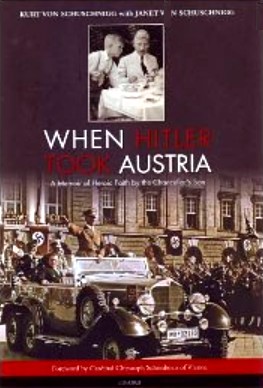 Fred
writes: Fred
writes: "German Austria must return to the Great German mother country..." Adolf Hitler, in Mein Kampf. These were the words of Hitler himself and, on March 12, 1938, Austria effectively ceased to exist as an independent nation, but not without resistance from the Austrian public, who were to have a plebiscite on the following day (polls showed that 65-70% of Austrians wished to retain their independence). "When Hitler Took Austria" is truly an exciting book by the son of Austrian Chancellor Kurt von Schuschnigg and tells of his eventual escape (one step ahead of the Gestapo) to neutral Switzerland and of his eventual reunification with his family, who were devout Catholics and placed in a concentration camp after the Anschluss... Although Burgenland is never mentioned per se, the book still gives valuable insight of those difficult times when Austrian families were separated from each other and sometimes killed. Published by Ignatius Press, I bought my copy used on Amazon.com for under $20 and will donate it to the St Mary's Catholic Church library in Schwenksville, PA, for those of you who may live in the area... Burgenland Recipes: Here is the second recipe being reprinted by permission of the Austrian Donau Club in Connecticut. Our thanks to Dennis Kern, President of the club, and to Mary Hoisl, who provided this recipe. Yum! NOODLE KUGEL (from Mary Hoisl) 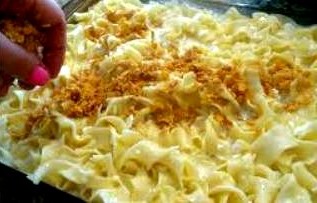 1/2
lb. medium noodles 1/2
lb. medium noodles3 eggs, well beaten 1/2 tsp. salt 1 Tbsp. sugar Dash of cinnamon 1 lb. cottage cheese 1/2 pt. sour cream 1/8 lb. butter 1 c. milk or 1 smal1 can evaporated milk Cook noodles in salted water for about 10 minutes. Drain; rinse in cold water. Mix remaining ingredients; add noodles. Pour into well greased pan (9 inch). Top with some crushed corn flakes. Bake in 350° oven for 1 hour or until browned. I also want to do some follow-up on last month's recipe: "Beef Soup With Liver Dumplings" provided by Linda Poglitsch. As you will see, the first commentary vouches for the authenticity of the recipe... but the second commentary "debates" one small point, a point probably modified by the slightly greater affluence caused by a move to America... I'll let you read: Richard Potetz writes (to Frank Paukowits and me): I thought you both would like to know the Burgenland origin has been verified for last month’s liver dumpling soup recipe. I checked with my cousin Linda (Sucher) Poglitsch, who learned to make that soup from her mother Berta (Werner) Sucher, born in Sankt Martin an der Raab. 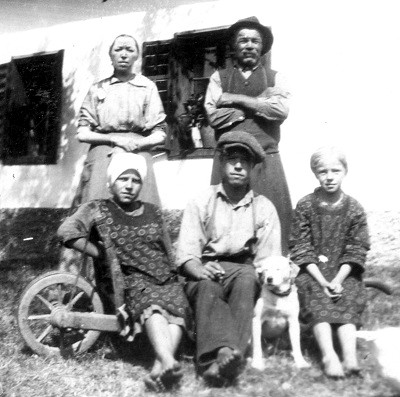 By
the way, even though Linda and her husband Karl enjoyed that soup, Linda’s daughters were not
fond of liver soup. And Linda’s sister, Traude (Sucher) Bockholdt tells me “Linda always loved
liver dumplings, I hated them and still do.” By
the way, even though Linda and her husband Karl enjoyed that soup, Linda’s daughters were not
fond of liver soup. And Linda’s sister, Traude (Sucher) Bockholdt tells me “Linda always loved
liver dumplings, I hated them and still do.” In case you ask how I am related to Linda, I’m attaching a photo taken in 1929. Standing behind the wheelbarrow are grandparents of Linda and me, Rosina (Pfister) Sucher and Johann Sucher. Their three youngest children, all barefoot, are sitting on the wheelbarrow. Hermann Sucher, in the center, is Linda’s father. On the right is my mother, Anna (Sucher) Potetz. Anna is nearing 95 but her memory is fine; she tells us when the weather was good she only used shoes to go to school and church. :-) Picture: Sucher Family with Wheelbarrow, 1929 Standing: parents, Rosa and Johann Seated: barefoot Mary, Hermann and Anna Their dog Mingel is seen in many Sucher family photos. Best wishes, Richard In addition, Christine Pöltl Rubba wrote, saying: The Leberknoedel sound delicious and seem easy to make. The only thing I remember is that we never used beef liver, it was always pork liver. Remember, we had "Sautanz," where a pig was slaughtered and cut up and then the meat used and preserved in different ways. [Ed. Note: Christine is author of Article 2 of this newsletter, wherein she tells us of her Burgenland life in Steinberg and Oberpullendorf, before she moved to Canada.] I replied to Christine: I wondered about the beef liver thing… very strong tasting… but I was thinking chicken livers, not pork… I can’t recall ever having pork liver… but why not! Christine replied: Beef liver was something no one could afford. Most of the "Bauern" had "Milchkuehe," so milk was the main product for butter, or it was picked up at the milk station daily. My grandmother made butter and traded it in Vienna for whatever, thread, cloth or nails. I also asked: Sautanz – sow dance? Are you saying you had a little festival around slaughtering time, perhaps as an excuse to quickly use up those parts that could not be preserved? Christine replied: Sautanz: a big event. All year the pigs were fed, I remember most had two, age I do not remember. One was usually slaughtered close to fall, i.e., harvest, probably. Then my uncle came, Sepponkel (Josef Ferstler, a brother of my grandmother) and he shot the pig and then slaughtered it. T 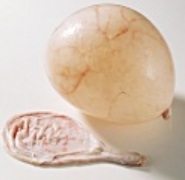 hat
part I never saw. Then the meat was cut up, I saw some of that. I remember helping with the
"Blutwurst," which was made with buns and blood and meat, and I was allowed to crank the
handle helping to fill the intestines (which were cleaned before, of course). I helped to pull
up the skin on a long metal thing and then, turning the handle, we filled the sausage into the
intestines, turning every 6 inches or so. hat
part I never saw. Then the meat was cut up, I saw some of that. I remember helping with the
"Blutwurst," which was made with buns and blood and meat, and I was allowed to crank the
handle helping to fill the intestines (which were cleaned before, of course). I helped to pull
up the skin on a long metal thing and then, turning the handle, we filled the sausage into the
intestines, turning every 6 inches or so.The best part was the liver. Fresh pork liver was cut into small pieces and fried with lots of onions in a large skillet, iron cast, diameter of about 14 inches, with a two inch rim, on the stove, built in, at my grandmother's place. One more thing I remember: the bladder was cleaned and blown up by the boys and they played Fussball with it. 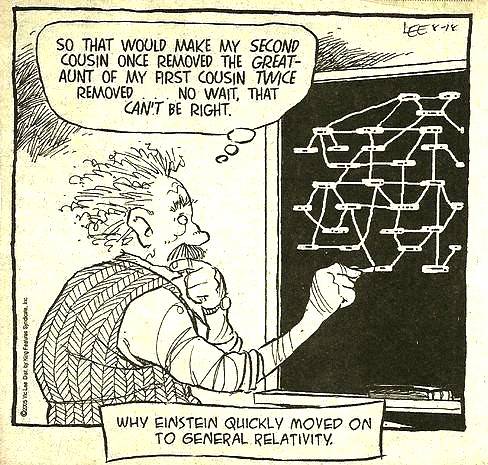 Cartoon
of the Month: Cartoon
of the Month: |
2) CHRISTINE REMEMBERS… (by Christine Pöltl Rubba) Ed. Note: This is a two-part article, with the second part to be published next month. When Christine Rubba joined the BB a few months ago, I noted that she, rather than her ancestors, had emigrated from Burgenland to Canada. Since we seldom are able to hear an emigrant's first-hand stories of life in Burgenland and then of life in her new country, I wrote to Christine asking if she would tell us about her memories of Burgenland and the process and result of emigration. She kindly agreed to do so. This first part speaks of her time in Burgenland and takes us to her arrival in Canada. [The second part, to be published next month, is a response to a series of questions I asked. Christine will touch just a bit more on the emigration process then will cover her time in Canada.] My thanks to Christine for sharing her memories! 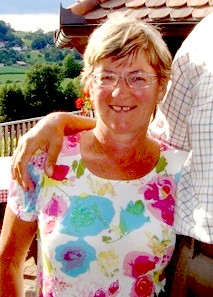 CHRISTINE
REMEMBERS… (by Christine Pöltl Rubba) CHRISTINE
REMEMBERS… (by Christine Pöltl Rubba)I was born on a holiday in June 1947 in the small town of Steinberg, located in the middle part of Burgenland, only 3 km from the village of Oberpullendorf. Oberpullendorf is the Bezirksvorort (district seat) for 64 small towns, where some towns have a population with a mixture of three languages, German, Croatian and Hungarian. In 1947, St. Peter and Paul was a holiday, and people enjoyed getting together, first in the church for Sunday Mass, and then for the “Segen” (blessing) at 2 pm. Today, it is no longer a public holiday. My father Viktor Pöltl, born April 1913, was a musician by heart—clarinet and saxophone—and played in the Gangl band. However, he had to learn a trade so his mother, Aloisia Pöltl, sent him to a woman in Steiermark who taught him to knit on a small machine. Soon he learned to knit socks. After getting married in 1940, I believe, he started his own knitting company. My mother worked by his side and soon they started to knit sweaters and pullovers. They used horse-drawn buggies to go to the markets, called Pferdemarkt (horse market) or Bauernmarkt (farmer's market). They had to get up very early to make it to these places. Soon, they got together with other Steinberger town people who were selling kitchenware, shoes or clothing, e.g., die Mantelschürze (an apron that covered the dress completely), Kopftücher (square pieces of cloth that the women wore on their head to protect their hair, or Bettwäsche (bed sheeting), or home made toys for the kids. At that time, not everyone owned a car so the group hired a truck, put all their merchandise in the back—where they also sat—and ventured out to newer territories. My parents became Marktfahrer (stall holders) and were selling their self-produced merchandise. Trust was soon built between customers and my parents, which meant that people were looking for my parents at these markets. Most little towns had 4 markets in a year, originally Pferdemarkt, where farmers sold and purchased horses, cows, pigs, chicken, eggs, and produce. Some had a market monthly and some even weekly. In the Sixties, merchandise moved in and horses and animals out. To this day, these markets are popular, and my nephew still sells his knitted pullovers and sweaters for ladies and men at markets ranging from Neusiedl am See to Mattersburg to Eisenstadt, Pamhagen or Oberwart (which still holds the weekly Wednesday market). 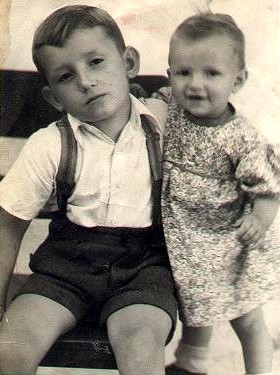 Steinberg
had a big convent where nuns taught the children. I still remember that I loved to go to the
kindergarten. My mother Anna, maiden name Loibl, born October 16, 1920, told me this anecdote: Steinberg
had a big convent where nuns taught the children. I still remember that I loved to go to the
kindergarten. My mother Anna, maiden name Loibl, born October 16, 1920, told me this anecdote:I was two years old, or maybe more, and kindergarten usually started for kids at age 3. So this nun walked by our house when my mother was doing the laundry. A big wooden trough was filled with warm water which mother heated up in the back yard in a special oven, and she was scrubbing the laundry with a big bristle brush. I was playing or doing whatever and this nun asked my mom why I was not in the kindergarten. My mom told her that I was not old enough yet. So this nun said to her, to send me anyway and to pack extra cloth diapers or pants (not sure which) in my little kindergarten bag. I still remember this bag. It was firm, had a lid to open, and a long handle so I could sling it over my shoulder. I loved kindergarten! Every day we had to take a nap on small cots in the afternoon. We had to go home for lunch and come back for the afternoon. 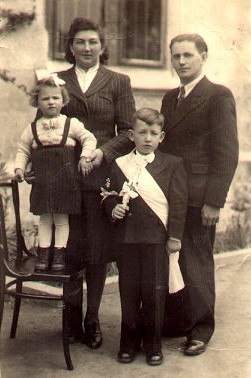 In
1953, I started grade 1 Volksschule, 1. Klasse (elementary school, first class) and,
after classes in the morning, I snuck into the kindergarten to give the kindergarten teacher
(nun) a hug. I also remember that I was so small I could hardly reach the handle of the
door—it was so high for me. In
1953, I started grade 1 Volksschule, 1. Klasse (elementary school, first class) and,
after classes in the morning, I snuck into the kindergarten to give the kindergarten teacher
(nun) a hug. I also remember that I was so small I could hardly reach the handle of the
door—it was so high for me.In 1954, my parents moved to Oberpullendorf, where they had purchased a house located right beside the middle of the main road. Soon, they started to take down the old house and build their own first house. At that time, a lot of people in Steinberg had worked hard to improve their lives. They drove to many markets and soon the Marktfahrer made enough money to buy their own cars. They were a diligent group and quite a few of them became business people like my folks and built their stores in Oberpullendorf. But let me tell you a little from before I was born... My parents, Anna Loibl and Viktor Pöltl, married in 1940, and soon moved into their own house in Steinberg an der Rabnitz, which was located right across from the church. They owned the left side front and had three rooms and a large open basement underneath. The front room was the business place where my dad had his knitting machine and where mom put the parts together to make sweaters, pullovers, socks, etc. The next room was the kitchen, where we practically lived—it was kitchen, eating room, and living room, all rolled into one. And then there was the bedroom. All I remember (from stories I was told and from the last years we lived there) is that there was a double bed for my parents, and a small ottoman across at the bottom of the bed, where my brother slept. Me, I was told, I slept with my parents. My dad complained to me, years later, that I always liked to sleep across, between them, and was either kicking him or had my head on his side. Behind our house there was a room for wood, wash trough, etc., and then another house, attached to ours. It was a low house—only two rooms, that I remember—and an older lady lived there by herself. We had a big road, a Hofeingang (courtyard entrance) between us and our neighbor, another house—3 rooms, no basement—which was lived in by Frau Schedl and her son Willi. They had a pigsty attached to their house, where they usually had 2 pigs. The back of the yard was divided up between three families living there. 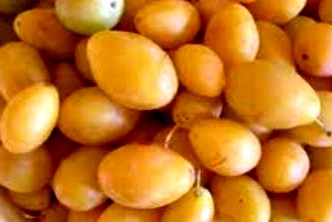 The
only thing I really remember is that there was a huge tree with yellow prunes—small, oval,
very sweet, and we called them “Sperling” (sparrows). To this day I was not able to
find that fruit again. The tree is gone long time ago, but the memory of it lingers. The
only thing I really remember is that there was a huge tree with yellow prunes—small, oval,
very sweet, and we called them “Sperling” (sparrows). To this day I was not able to
find that fruit again. The tree is gone long time ago, but the memory of it lingers.Coming back to our house: it had two entrances, one on the street front, where people could walk in when they wanted to buy some sweaters, and then there was a side entrance, with 4 steps up to a small porch. It had a small board attached, which could be put up, and I did my homework on it (Grade 1), and it could be lowered so it was only attached to the wall of the porch. On the other side of the porch were another 4 steps so you could go down again and get to the laundry/basement. The unusual thing with this house was, first, it had a basement, and second, it had two entrances to this basement, which were located on each side of the porch steps. In 1945, when people of Steinberg were hearing that the Russians were coming, the town folk decided to hide in the forest. My grandfather, Stefan Loibl, and his wife, Maria, born Ferstler, were living in their house on the other side of the town. Their house was the only one that did not share its yard with another family. My father was working in Wiener Neustadt in a cloth factory; since his eyesight was so bad, he was not drafted. So, my mother was, with my brother Viktor, all by herself and did some quick thinking when she heard that the Russians were coming. She lugged the knitting machine, sewing machine and whatever equipment they had down into the basement. Then she put all clothing, coats, cutlery, and dishes in suitcases and boxes and took it downstairs as well. She even asked her mother, Anna Loibl, whether she wanted to give her a suitcase of good clothing of her brother Stefan, who was fighting the war in Ostpreußen (East Prussia), or her dad, but my grandmother laughed her off. Then she put up a wall downstairs with bricks and sand, no cement, put the machines, etc. next to it, and put up another wall on the other side. So, when someone entered the basement on either side of the porch, they saw the basement and a wall. She leaned the laundry trough against it to disguise the new wall. And then my mother Anna went with my brother Viktor with all the town folk into the forest and waited for the Russians to arrive. And they did come. My grandfather came to the forest later—he had refused to leave his house—with bad news for my mother: their house had been burned down. A house "burning down" meant the roof structure, and the porch, and anything made of wood, was gone. But the wise decision of my mother, to hide all the machines and clothing and stuff helped them to start all over. As for my grandfather, Stefan Loibl: since he had the only house without any parties or families, the Russians decided to use his house as their “Hauptsitz” (headquarters). So, with my parent's house burned down, my mother moved in with her parents (after the Russians left). But back to my life... 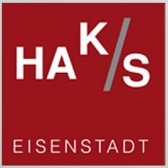 In
1963, I had finished two years of Handelsschule (business school), but I wanted more. I
wanted to attend the Handelsakademie (business academy) so I would get better paid when
working. Also, I was having this dream to go abroad to work at an embassy where I would be
able to use my new language skills, English and French. French was a required language skill
at the Handelsakademie and I wanted that very much. I was fifteen-and-a-half and full
of enthusiasm and ideas. In
1963, I had finished two years of Handelsschule (business school), but I wanted more. I
wanted to attend the Handelsakademie (business academy) so I would get better paid when
working. Also, I was having this dream to go abroad to work at an embassy where I would be
able to use my new language skills, English and French. French was a required language skill
at the Handelsakademie and I wanted that very much. I was fifteen-and-a-half and full
of enthusiasm and ideas.So, I put an ad into the Wiener Wochenschau, a weekly paper where there were the famous Fortsetzungsromane (serial novels); people liked those. My ad was as follows, in German:
I got a into a lot of trouble with my parents for doing this. They considered this as very
naughty. Anyway, I received 3 letters, one from Austria from a girl, one from a young man from
Egypt and one from Canada. I exchanged 2 letters with the young man from Egypt but, when he
wrote he wanted to visit me, I dropped writing to him immediately; he was just not my type. |
3) HOUSE VULGO NAMES & NiT NICKNAMES (by Jack Fritz) 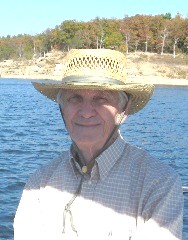 Ever
since I was a young child, I wondered about Neumarkt in Austria, where my grandmother, Gisela
Fritz, and grandfather, Johann Fritz, had lived prior to their emigration to Chicago. Ever
since I was a young child, I wondered about Neumarkt in Austria, where my grandmother, Gisela
Fritz, and grandfather, Johann Fritz, had lived prior to their emigration to Chicago.In late 2007, a few months after I had retired, I decided that the time had come to delve into the mystery of Neumarkt im Tauchental (NiT). My grandmother had died in Chicago in 1991 at age 99; however, quite sometime prior to her passing, she had given me a four-page letter which had come from someone in the old country. I knew some German, but it was handwritten in the old German script and I could not make heads or tails of it. The only thing that I could recognize was the name Zartler, which was my grandmother’s mother’s name. I learned of the BB and solicited help in translation of the letter and Fritz Königshofer graciously translated the letter and, later, he also translated an old postcard photo showing a house in NiT along with the residing family and friends. It was on the back of the house photo that appeared a name “Schweinyszer?,” 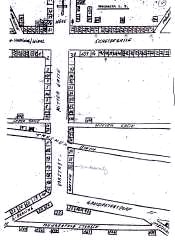 which
Fritz could not quite understand but he suggested that it may be a vulgo house name
[Ed: vulgo is Latin for "common"]. And that is exactly what it turned out to be. Fritz
also could not tell if a person’s name was Mari Morth or Marth. At a later date, I came upon
an NiT house list, circa 1900, which showed not only house numbers and owners names but also
the house vulgo names [Ed: click image at right to view the list and a map]. The house
with the vulgo name of Stefan Schweinsger was owned by Marth and was number 28. No
doubt the purpose of including the vulgo name on the postcard was to allow the readers (in
Chicago in 1910) a better insight into exactly who this person was. which
Fritz could not quite understand but he suggested that it may be a vulgo house name
[Ed: vulgo is Latin for "common"]. And that is exactly what it turned out to be. Fritz
also could not tell if a person’s name was Mari Morth or Marth. At a later date, I came upon
an NiT house list, circa 1900, which showed not only house numbers and owners names but also
the house vulgo names [Ed: click image at right to view the list and a map]. The house
with the vulgo name of Stefan Schweinsger was owned by Marth and was number 28. No
doubt the purpose of including the vulgo name on the postcard was to allow the readers (in
Chicago in 1910) a better insight into exactly who this person was. When we were children living on Chicago’s north side, I can vividly recall my father taking my brother Tom and me to John Muellner’s poultry store on North Avenue just west of Crawford Avenue (Pulaski today). Probably what seared this into my memory was the sight of chickens after they met the axe at the chopping block and then watching them run around headless across the sawdust covered floor. Sometime after I got into working on our family genealogy, my Aunt told me that when she was a young girl, she and a friend used to taunt John Muellner by sneaking up on him and calling him Kotl Hans and then running away laughing. After receiving the NiT house list circa 1900, I realized that Kotl Hans was John Muellner’s NiT nickname and that he was no doubt born in NiT house number 99 which had the vulgo name of Kotl and, according to the circa 1900 house list, was owned by Müllner. The NiT nicknames frequently incorporated the house vulgo name. My grandfather, Johann Fritz, was known as Winter Hansl and his house #7 had the vulgo name Winter. My grandmother, Gisela Fritz, had the nickname Goshba Giezie and her house #82 had the vulgo name Goshba. NiT nicknames probably had a very practical reason to exist. For instance, the population of NiT around the year 1900 was just slightly less than 1000. However, there were many, many unrelated (we hope) people with the surname Fritz. Compound this with the fact that a rather few given names were constantly recycled, such as Stefan, Johann & Josef and it is quite likely that, at any given moment in time, there were several half-dozens of people in NiT with exactly the same. However, there was only one person with a given nickname and he was, thusly, easily identified. Now take the case of my grandmother’s brother-in-law, Josef Fritz, who we hope was not related to her sister (his wife Amelia). He came from NiT house #4 with the vulgo name of Tula. His real name was exactly the same as his father-in-law, Josef Fritz. When I was a young child, we lived next door to Joe and Amelia on Dickens Avenue in Chicago and we called them Uncle and Aunt and I recall Uncle Joe as being a kind soft spoken grandfatherly man, a retired bricklayer. However, his nickname was Damenie Joe, which I suppose you could translate as “Ladies Man.” So, the moral of the story is that vulgo names and nicknames can be helpful in providing genealogy clues ...but can also be puzzling as well. 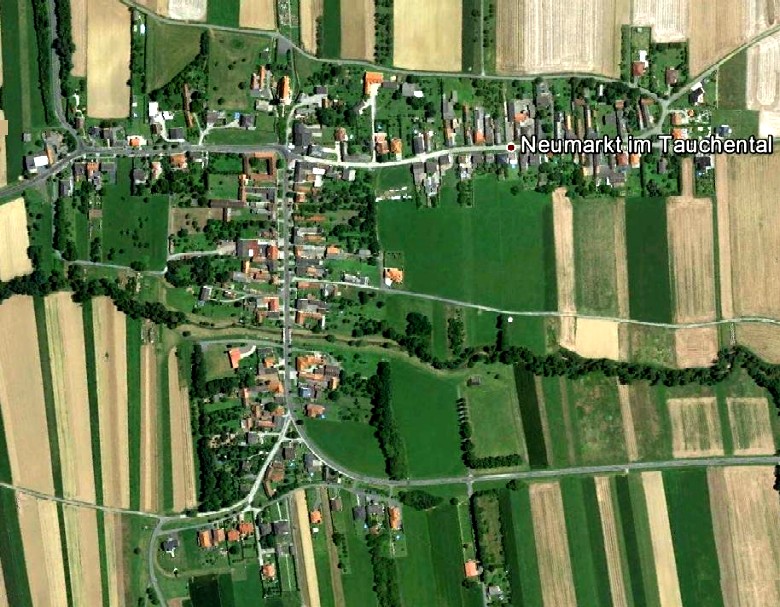 Satellite image of current-day Neumarkt im Tauchental (rotated with north nearly to the left to match Jack's house number drawing) Ed note: I have never seen a vulgo name list for houses in my main Burgenland villages (Wallern and Halbturn) but I know such naming conventions are not uncommon in Burgenland (or elsewhere in Europe) and we include some vulgo names on the BB Houselist pages (we will add the NiT vulgo names). Even in America, if you have ever needed directions in a small town, you likely have been told something like "...and then turn left at the old Schmidt house." The 'old Schmidt house' being the equivalent of a vulgo name, though not as formalized as the European vulgo names! Despite not having vulgo names for my Burgenland villages, such names have been useful to me: one of my Burgenland lines (Weiss) married into a Schaefer(s) line from Hegensdorf, Westphalia, Prussia. The Hegensdorf website provides an "Auswanderer" (Emigrant) list for years 1824-1893. On it is this entry for my Schaefer family: "1856 Schaefers, Hermann gen. Schojohann Hnsr. 32 mit Familie; 2 Töchter, 6 Söhne; Ziel: Amerika." This translates to: "1856, Hermann Schaefer, known as 'Schojohann,' house number 32, with family; 2 daughters, 6 sons; Target: America." It was this bit of text, which included the Schojohann house name, that let me know I was tracking the right Schaefer family in the Hegensdorf records (there was more than one Schaefer family!). Unlike Jack, I have never experienced a nick-name connection to vulgo names ...but, clearly, such a connection makes good sense. Regardless, like Jack, I suggest you pay attention to these seemingly odd names... they may prove very useful! |
4) US VITAL RECORDS IN BURGENLAND REGISTRIES BB Member Joe Jarfas raised an interesting idea this past month when he sent a note about an image of a page from the civil records of Pinkamindszent (Allerheiligen), Hungary. Specifically, the page was from the 1910 marriage records and two of the three entries on the page were for marriages that occurred in the United States. Joe proposed that this page would be a good example if I were to write an article about this phenomenon of US vital records appearing in Burgenland registries. Being able to take a (good) hint, I wrote back to Joe (and later to the BB staff) that I thought it would be worthwhile to share both the phenomenon and the reasons for it in the BB Newsletter. This article reports part of the exchange with Joe and the BB staff, as well as some additional information I found while investigating the topic. Joe Jarfas wrote: Hi Tom, a friend of mine and fellow researcher in Györ found a relevant marriage for me in the Pinkamindszent (Allerheiligen) civil records (they are in the middle). 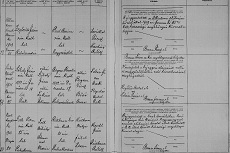 But
I could not help noticing the other marriages ... and both from the good ol' US of A! :-) I
thought if you ever 'concoct' an article about 'transferring' vital records to the old country
registries, this will be a good example. [Ed note: Rather than insert an
overly-compressed copy of image Joe sent to me (compressed so it will fit the width of the
newsletter), I'll inserted a link to a full-page image here; If
you'd like to see the record, just click the link; alternatively, you can click the thumbnail
image to the right.] But
I could not help noticing the other marriages ... and both from the good ol' US of A! :-) I
thought if you ever 'concoct' an article about 'transferring' vital records to the old country
registries, this will be a good example. [Ed note: Rather than insert an
overly-compressed copy of image Joe sent to me (compressed so it will fit the width of the
newsletter), I'll inserted a link to a full-page image here; If
you'd like to see the record, just click the link; alternatively, you can click the thumbnail
image to the right.]I replied: Sounds like a good idea, Joe! Fritz Königshofer has often mentioned US marriages, etc., being recorded in Burgenland records but I’ve never noticed one. Here you have two on one page! I suspect the reason I’ve not noticed more of these is that I’ve not explored the newer multi-events-on-one-page records as much as the older, long-form records (my people were long gone and well settled in the US by the time such multi-forms were used)… and I suspect the US events are in the handwritten side text of the long forms, which is so much harder for me to decipher; I often only search out the names involved (if I even look at such text), so may not have noticed the location. (However, I have seen stuff like this in family records from regions my other ancestors came from). I think I’ll bounce a note to the staff asking about the motivation behind recording such in the old country registries (I suspect is was mainly by people intending to return) or other thoughts on this. Do you have comments about this? I attempted to translate the comment text from the records you sent. It seems the obvious stuff, however, the way it is run together makes translation difficult for me. I’ll insert my transcriptions below and ask you for corrections and a better translation, OK?
Why the vital records were entered into 'home' registries? Your first take is the main
reason: Many people came out to make some money and to return, buy more land and live happily
ever after. But there were other 'motivations' as well. The Hungarian Government—and the
approved ministers of the churches (pretty much most all denominations)—were promoting the
idea of not 'reneging' contact with the 'home' land and to give descendants an easier time to
return, should they so desire (even the Communist governments followed this idea).
'Resettlement' is a long process (just like getting citizenship here): years of residency
requirements, knowing the language, and doing lots of paperwork. But if one has registered
his/her marriage here (actually anyplace in the world), the birth of their children—or even
grand children—for them the resettlement is easy: they just point out their Hungarian
registration and became citizens automatically. |
5) AN "UNREADABLE" BIRTH LOCATION We had a recent potential new member, Eric Hausen, who provided surnames Setler and Schmidt from Rétfalu. In his text section of the member registration form, he said: "My great-grandfather Martin Setler and my great-grandmother Elizabeth Setler (nee Schmidt) came to America through Ellis Island in 1913 and settled in Pittsburgh, PA. The ship manifest for Martin lists Retfalu as his last residence, but birthplace is unreadable city in Hungary. Elizabeth's father is listed as Peter Schmidt living in Retfalu." This all seemed reasonable, as the Burgenland village Wiesen in Mattersburg was known as Rétfalu to the Hungarians. However, the comment about Martin's birthplace city being unreadable caught my eye. Given that is was an Ellis Island manifest, I decided to take a look. Without too much effort, I found it... below were the entries in the "Place of Birth" columns:  Clearly,
the first is Hungary, but what is the second? To the inexperienced eye, this is, indeed,
unreadable... but I did make it more difficult for you by cutting all surrounding text, which
would help you learn the "hand" (i.e., the writing style). However, even with that, I don't
think you could form this into a Burgenland village name, as Burgenland and nearby Hungary
have no villages with a name like this in either the German or Hungarian form. So I dug
deeper... Clearly,
the first is Hungary, but what is the second? To the inexperienced eye, this is, indeed,
unreadable... but I did make it more difficult for you by cutting all surrounding text, which
would help you learn the "hand" (i.e., the writing style). However, even with that, I don't
think you could form this into a Burgenland village name, as Burgenland and nearby Hungary
have no villages with a name like this in either the German or Hungarian form. So I dug
deeper...To keep it interesting, Martin Setler reported he was born in Croatia in the 1920 US Census, in Yugoslavia in the 1930 US Census, and in Austria in the 1940 US Census! So I pulled his WW-I Draft Registration card... he lists Austria Croatia there! His WW-II Draft Registration card, lo and behold!, says Croatia again. Then I stumbled on the Hamburg Passenger List for the departure of Martin's ship to the US... it gives his Bisheriger Wohnort (previous residence) as Leipzig, Ung., which, of course, makes no sense at all! ...but it is the right ship and right departure date! Then I found his Naturalization papers... there is says Martin was born May 7, 1880 in Semelee, Croatia ...or does it?  As
you can see, the village name was typewritten... but all the open letters have filled in.
Nonetheless, with this and the repeated "Croatia" in different documents (Croatia was part of
Austria-Hungary and Yugoslavia at different times, so those work as "Croatia" too), I was
pretty certain we were looking for a Croatian village name that started with letters "Se" ...
with that, reading the rest of the village name from the passenger manifest above was not too
difficult: Semeljci. And, the typed text in the naturalization papers then appears to
be Semelce, which likely was a phonetic spelling of what was verbally reported. A quick
look online confirms that Semeljci is a town in Osijek-Baranja county, Croatia (formerly part
of Veröce county, Croatia-Slavonia, in the Hungarian part of the Austro-Hungarian Dual
Monarchy), which is way over on the eastern end of Croatia, a long way away from Burgenland
(about 430 km / 270 mi) by the most direct route. As
you can see, the village name was typewritten... but all the open letters have filled in.
Nonetheless, with this and the repeated "Croatia" in different documents (Croatia was part of
Austria-Hungary and Yugoslavia at different times, so those work as "Croatia" too), I was
pretty certain we were looking for a Croatian village name that started with letters "Se" ...
with that, reading the rest of the village name from the passenger manifest above was not too
difficult: Semeljci. And, the typed text in the naturalization papers then appears to
be Semelce, which likely was a phonetic spelling of what was verbally reported. A quick
look online confirms that Semeljci is a town in Osijek-Baranja county, Croatia (formerly part
of Veröce county, Croatia-Slavonia, in the Hungarian part of the Austro-Hungarian Dual
Monarchy), which is way over on the eastern end of Croatia, a long way away from Burgenland
(about 430 km / 270 mi) by the most direct route.I reported this back to Eric, and to the BB team that reviews new member registrations, but I wondered why Martin ended up in Wiesen (Rétfalu), so very far away from Semeljci, Croatia. One thing Martin's naturalization papers included was a listing of his children... there I saw that son Karl was born Sept 7, 1909 in Austria-Hungary. Given we have easy access to the civil records, I decided to look him up in the birth records and also to look up Martin and Elisabeth's marriage. While the data Eric shared did not say exactly where these events took place, it seemed likely that they were in Rétfalu... after all, Eric reported that "Elizabeth's father is listed as Peter Schmidt living in Retfalu" so it seemed probable that the marriage and birth should have taken place there. Given an exact birth date for son Karl, it did not take long to browse through the records... but no Karl! I scratched my head and went through the pages again... even looked for a "late return" in the following year... but nothing! So I tried the marriage records, working back from Karl's reported birth date. After checking from 1909 back to the start of 1905, I gave up... nothing there too. This prompted another note from me to Eric, asking (in part): "What makes you think Elisabeth was born in Retfalu?" Meanwhile, Fritz Königshofer replied, saying: "There was a town with name Rétfalu in former Veröce county of Croatia-Slavonia, near Osijek, now in Croatia, just a few miles up the river Drava. The majority of the population was ethnic German. I agree that Eric's data point to Croatia, not Burgenland. The German name of Rétfalu in Slavonia was Rietdorf, and it likely belonged to the German settlement region called Batschka." 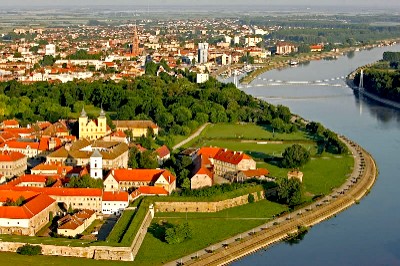 Eric
replied to Fritz, copying me: "Hello Fritz, in looking at the passenger manifest for
Elizabeth Setler, nationality is listed as Hungary, “race” is listed as German, but Rétfalu,
Croatia is listed as last permanent residence and birthplace. The Hungary part led me down the
path of Burgenland, the searches I did for Rétfalu pointed to the Burgenland town, not the
Croatian town you mention. I think you are right, no Burgenland here…oh well? I do very much
appreciate the clarification and the information you provided will allow further research.
Thanks for your help. Eric Eric
replied to Fritz, copying me: "Hello Fritz, in looking at the passenger manifest for
Elizabeth Setler, nationality is listed as Hungary, “race” is listed as German, but Rétfalu,
Croatia is listed as last permanent residence and birthplace. The Hungary part led me down the
path of Burgenland, the searches I did for Rétfalu pointed to the Burgenland town, not the
Croatian town you mention. I think you are right, no Burgenland here…oh well? I do very much
appreciate the clarification and the information you provided will allow further research.
Thanks for your help. EricI then replied (in part): "This does make good sense. My look at the current-day map shows Rétfalu being totally absorbed into Osijek (it is the western-most part). ...if she was, in fact, born in Rétfalu, that puts them [close] together and more likely to have met each other. Which is good for you but certainly nixes a Burgenland connection. Given all this, I’m not going to process your BB membership entry (as all these places are well outside the BB’s research interest), but I will wish you good hunting and note that LDS has microfilm for both Rétfalu and Semeljci." 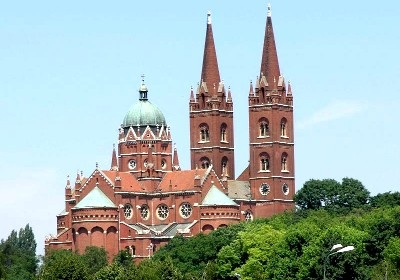 Eric
also replied to me, saying (in part): "Hi Tom, I’ve attached a picture of Martin and
Elizabeth Setler holding an infant Karl (Carl). The stamp on the back shows the photographer
in Djakovo, which I now know is near Semeljci. Eric" Eric
also replied to me, saying (in part): "Hi Tom, I’ve attached a picture of Martin and
Elizabeth Setler holding an infant Karl (Carl). The stamp on the back shows the photographer
in Djakovo, which I now know is near Semeljci. Eric"To top that off, Eric also discovered he had Karl's baptismal certificate, which clearly showed the baptism took place in Đakovo [Djakovo] and that the family was living there at that time. So, it seems Eric has confirmed that we have shifted his research into the correct geographic area. That seems like a satisfying end to this story, doesn't it? But we are not quite done... While pulling up the passenger list again to copy part of the image, I looked more closely at the other information for Martin. This is the part worth looking at:  These are the columns for race, last country and city of residence, and nearest contact in the old country. As you can see, it was evident that Martin was Croatian, and had been living in "Hungary" in the city of... well, what is that city? It is given both as Martin's city of residence and for his nearest contact, his wife, who is still in that city. What is says is Esseg Rédfalva. If you've worked much with Hungarian village names, you likely know that "falva" and "falu" are interchangeable... both mean "village." So, this could have been written as Esseg Rédfalu. Also, you may recall that Fritz reported that "The German name of Rétfalu in Slavonia was Rietdorf." Of course, "dorf" is German for "village." In addition, other sources say Rétfalu was also known as Deutsch Rieddorf. Things are starting to look similar here, aren't they? We have "Réd- / Ried- / Rét- / Riet- village." The last bits you need to know are 1) that "Esseg" was the German name for Osijek and 2) that Rétfalu, by whatever name you chose to call it, stood beside Osijek and now has been totally absorbed into it, so saying Esseg Rédfalva for Rétfalu was being exceptionally clear... we just did not know it! Thus, in the first document Eric mentioned, Martin's passenger manifest, we had everything we needed to identify his region of origin and, had we been informed enough, we never would have confused Rétfalu/Wiesen, Austria with Rétfalu/Rietdorf, Croatia. Isn't hindsight wonderful? I suppose that, if there is a moral here, it is to pay attention to what the document says... don't let our biases lead us 430 km astray! However, just like Eric, I missed the significance of this bit of text, and likely for the same reasons too. We had too little knowledge to understand what it told us and we were more interested in Martin's place of birth, not place of residence. I'll wrap this up with just one more item... Eric and I closed out our conversation with some exchanges about the Osijek area being resettled by Germans after the Turks were driven out. As such, those earlier settlers were considered to be part of the "Donauschwaben." Surprisingly, though, Eric said "...[I] found a source that mentioned German settlers from the Burgenland established some towns in Slavonia, including Martin's birthplace Semeljci. I've contacted some people that specialize in this area. I need to get more information on Martin's and Elisabeth's parents to hopefully research where they lived before settling in Croatia." Having now read the source that Eric quoted, I don't believe that Semeljci was settled by Burgenländers. The text does say, though, that "...Western and central Slavonia were the locales of the most important of these newly established enclaves: Gross-Pisanitz (1881), Palesnik (1882), Klein-Bastei (1885), Marjanci, Colinci (1870), Kucanci (1876) Cacinci (1908) and the vicinity of Trnjani (1890) and Garcin (1890). According to the mayor of Drenovac, the last two mentioned communities were settled in 1875 by colonists from the Burgenland: Oberndorf [Ed: Oberdorf], Kitzladen, Pinkafeld, Oberschützen, Wörterberg, Althau [Ed: Markt Allhau] and Sinnersdorf [Ed: just into Steiermarkt]. A second group of settlers from the Burgenland from the vicinity of Güns [Ed: Köszeg, Hungary] established themselves in Uljanik by Daruvar and some individuals went on to Kutina and Dolci. ...not more than one hundred or two hundred Germans were involved, but they were strong enough numerically to survive and maintain their German identity and in some places they formed the majority of the local population, some even eventually reaching five hundred German inhabitants." I was not aware that Burgenland sent large groups of settlers into Croatia, especially as late as 1875. Interesting! Of course, essentially all Germans were expelled after WW-II, so little trace now remains of these once German ethnic settlements. |
6) HISTORICAL BB NEWSLETTER ARTICLES Editor: This is part of our series designed to recycle interesting articles from the BB Newsletters of 10 years ago. This month, I didn't find anything from Feb 2003 that I wanted to reprint, so I'm going back even further, some 16 years ago, when Gerry published an article about the kind of food available to Burgenländers around 1900, with some of his personal reminiscences from the kitchens of his immigrant grandparents. Given we have started publishing Burgenland recipes again, this seemed an opportune time to reprint this overview. THE BURGENLAND BUNCH NEWS No. 14A July 5, 1997 FOOD IN PRE-EMIGRATION BURGENLAND In an older issue of the Burgenländische Gemeinschaft newsletter, in a column called "So war es damals..." (the way it was), Dr. Walter Dujmovits shared some scenes from his childhood. He describes his father, sitting at the head of the kitchen table, cutting a cross in a loaf of bread (a very old peasant form of saying grace) before presenting slices to each member of the family. First to the mother, then any other adults, then the children, oldest first and youngest last. (The youngest also had the privilege of scraping the bowl of the main dish). This was followed by serving portions of the main dish, in roughly the same order. This made me think of meals with my immigrant grandparents, who followed the same procedure. A baker named Oberecker (a Burgenländer) in Allentown, PA, delivered unsliced rye bread and Kaiser rolls, still warm from the oven, to their house on Jordan Street in the north end of town. It was post WW-II, before sliced bread (yech!) was delivered by the Freihoffer Bakery delivery van. 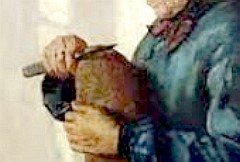 My
grandfather Alois Sorger from Rosenberg (Güssing) always sliced the bread by holding the loaf
in his left hand and cutting toward his chest. The loaf was left on the table on a bread board
with the knife. Years later, under my mother's prodding, bread was sliced before we sat at
table and put in a bread basket with a napkin, thus ending the ceremony. "Pop" would laugh
with pleasure whenever he handed me a piece of bread, maybe because the staff of life was
available in abundance in America or maybe just because he enjoyed feeding his grandson! My
grandfather Alois Sorger from Rosenberg (Güssing) always sliced the bread by holding the loaf
in his left hand and cutting toward his chest. The loaf was left on the table on a bread board
with the knife. Years later, under my mother's prodding, bread was sliced before we sat at
table and put in a bread basket with a napkin, thus ending the ceremony. "Pop" would laugh
with pleasure whenever he handed me a piece of bread, maybe because the staff of life was
available in abundance in America or maybe just because he enjoyed feeding his grandson!Food in the Burgenland of the turn of the century was very similar to that eaten in rural America. There just wasn't that much of it, particularly meat. Smoked or preserved meat ran out by Easter. A bad harvest could be a time of famine and there was little cash to buy what little food was available. Two bad harvests in a row could mean starvation. At the turn of the century, a few dollars enclosed in a letter from an emigrant relative was cause for rejoicing and could make a substantial difference in diet. The many memorials to immigrant relatives which we find today throughout the Burgenland attest to the fact that this generosity was not uncommon. Immigrants in the US knew from experience that their relatives could be in serious need of help. During good times, many meals might include the following: Bread, butter and milk or wine were breakfast items. Coffee (introduced when huge stocks of coffee beans were left behind by the Turks when they fled following the first siege of Vienna) was a luxury, but was always a breakfast item when the family could afford it. Tea (with Rum or Schnapps) was for sick or old people. With breakfast, the men of the house would have a small glass of "Schnapps" or white fruit brandy made from apples or cherries ("Kirsch"), the plum brandy "Slivovitz", or Hungarian "Barack Palinka" made from apricots. Many farmers distilled this themselves and sold some along with their wine to raise cash. Butter was not used at other meals, particularly when other fats or dairy products were present. Butter and eggs were "trading" items to be sold for necessities that couldn't be made or raised at home. Uncooked smoked bacon, cured with a coating of paprika, was cut into small cubes and eaten with breakfast bread or carried to the fields or job with bread and a small jug of wine and water for a mid-morning break. Cheese, or cold cured or smoked sausage of many varieties if available, was also a breakfast or break item. The mid-day meal was normally the largest meal of the day and often involved a clear soup (Tage Suppe), made from boiled beef, sometimes chicken stock. It included an addition or "Einladen" of noodles (home made), buckwheat "sterz" or dumplings (potato, bread, barley, semolina, liver or many other varieties) or rice or whatever was available. My grandfather never asked what kind of soup he was getting, he always wanted to know what the "Einladen" was. A soup could also be made from flour browned in fat ("Einbrenn") if meat wasn't available. "Einbrenn" was also used to season vegetables. The meat from which the soup was made was eaten as a second course with boiled potatoes or homemade noodles or in season vegetables. "Böhnen" 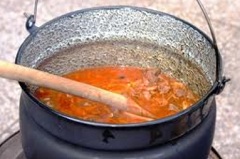 (bean)
Suppe and "Gulyas" Suppe, a very thin paprika flavored goulash soup were often made, as well
as creamed pumpkin soup. Knowing the value of greens, everything from wild greens like
dandelion to garden salad or onions, sweet peppers, cabbage or other vegetables were used as
salad. Cucumbers with sour cream were popular. Oil pressed from pumpkin seeds (Kernöl) or
sunflowers, and vinegar made from wine or cider was used as a salad dressing. Wild mushrooms,
nuts (almonds, walnuts, hazel nuts) and berries were picked to supplement food stocks. (bean)
Suppe and "Gulyas" Suppe, a very thin paprika flavored goulash soup were often made, as well
as creamed pumpkin soup. Knowing the value of greens, everything from wild greens like
dandelion to garden salad or onions, sweet peppers, cabbage or other vegetables were used as
salad. Cucumbers with sour cream were popular. Oil pressed from pumpkin seeds (Kernöl) or
sunflowers, and vinegar made from wine or cider was used as a salad dressing. Wild mushrooms,
nuts (almonds, walnuts, hazel nuts) and berries were picked to supplement food stocks.When greens were out of season, cold sauerkraut or cold boiled dried white beans with onions dressed with vinegar and oil served as a salad. Wine with water (wine was often mixed with water to taste) or apple or pear cider accompanied most meals. Wine was considered a basic food item. This was an old custom dating to medieval times when those employed by the nobility would receive a daily ration of bread ("Zipolte") and wine. Vineyards were introduced as early as Roman times and wine was drunk in all stages of its development, from the first press of the grapes ("Most") to just before it became vinegar. Considering that water sources were often polluted, mixing wine with water was probably a life saving habit. In Eltendorf and Königsdorf, a stream which still runs through the center of the village was the source of potable water. It was also used for washing, sewage (local ordinances specified only at night) and watering stock. Local church death registers are full of typhoid, dysentery and other causes of death due to bad water. 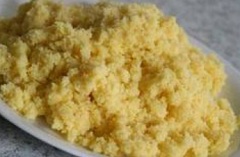 Supper
was frequently a one dish meal and could include such things as "Sterz" made from cornmeal,
boiled in salt and water, then cooked in lard (better than it sounds) or buckwheat flour and
water (sometimes mixed with blood from butchering or eggs) which was poured in a greased pan
and baked. Potato dumplings containing plums or apricots were boiled in water, then fried with
bread crumbs and sprinkled with sugar (Twestchen Knödel). A fine dessert. Homemade noodles
made from eggs, flour and water (with sometimes the addition of mashed potatoes to stretch the
flour) were eaten mixed with many things like cottage cheese (Topfen), ground nuts (Nussen)
and sugar, ground poppy seeds (Mohn), fried cabbage, pork crackling (Grammel - the crisp bits
remaining from rendering lard) or bread crumbs. Goulash (made much thicker than the Suppe) was
very popular and made in countless ways, all of which used lots of onions and sweet paprika
and would even be eaten for breakfast. If times were good, Goulash was always available.
Peppers filled with rice and meat in an Einbrenn tomato sauce were popular. A dish of barley
and beans (sometimes ham) cooked together was called "Richert" and was popular and filling.
For feast days and holidays, goose was the first item of choice. Geese were force-fed with
corn to enlarge their liver (pate de foi gras). I remember my grandmother holding a live
goose, wrapped in a towel, in her lap while she fed the goose all it could hold. I never ate
goose liver! The goose was kept in a cage in the covered alley way between her house and the
neighbors and would vent its displeasure by hissing at me if I came near. It's feathers would
later stuff home made pillows. Supper
was frequently a one dish meal and could include such things as "Sterz" made from cornmeal,
boiled in salt and water, then cooked in lard (better than it sounds) or buckwheat flour and
water (sometimes mixed with blood from butchering or eggs) which was poured in a greased pan
and baked. Potato dumplings containing plums or apricots were boiled in water, then fried with
bread crumbs and sprinkled with sugar (Twestchen Knödel). A fine dessert. Homemade noodles
made from eggs, flour and water (with sometimes the addition of mashed potatoes to stretch the
flour) were eaten mixed with many things like cottage cheese (Topfen), ground nuts (Nussen)
and sugar, ground poppy seeds (Mohn), fried cabbage, pork crackling (Grammel - the crisp bits
remaining from rendering lard) or bread crumbs. Goulash (made much thicker than the Suppe) was
very popular and made in countless ways, all of which used lots of onions and sweet paprika
and would even be eaten for breakfast. If times were good, Goulash was always available.
Peppers filled with rice and meat in an Einbrenn tomato sauce were popular. A dish of barley
and beans (sometimes ham) cooked together was called "Richert" and was popular and filling.
For feast days and holidays, goose was the first item of choice. Geese were force-fed with
corn to enlarge their liver (pate de foi gras). I remember my grandmother holding a live
goose, wrapped in a towel, in her lap while she fed the goose all it could hold. I never ate
goose liver! The goose was kept in a cage in the covered alley way between her house and the
neighbors and would vent its displeasure by hissing at me if I came near. It's feathers would
later stuff home made pillows.Fish (generally pond raised carp, or lake pike or smoked, dried or pickled fish) were available and eaten on Fridays and fast days. Local marshland near Güssing was drained by creating a fish pond "Teich". Tons of fish have been harvested from this pond. Neusiedler See was also fished. Fruit (apples, apricots, pears, plums, cherries) in season was eaten with bread or made into "Strudels", a many layered phyllo dough ("Retes") stretched paper thin, brushed with melted fat and covered with sliced fruit, sugar, spices and bread crumbs, then rolled into a pan sized "blanket roll", brushed with butter or fat and baked. Apple and cherry were favorites. Strudels were also made with a filling of cream, cottage cheese or cabbage or potatoes or chopped liver or turnips or anything else that was available. The non-fruit strudels frequently were served with soup. Sweet raised (yeast)  Strudels
with a filling of walnuts or poppy seeds (Mohn) and raisins and sugar were also made (try
making it in your bread machine; add grated lemon rind, Rum and cardamom for added flavor, and
roll and fill the dough after the first machine rising, rolling the finished strudel like a
jelly roll before baking). Thin egg and flour pancakes (crepes) called "Palatschinken" spread
with jam, rolled up and sprinkled with sugar were a dessert. When in Austria, that's how I end
every meal! I'd do it here if my wife and doctor would let me! Strudels
with a filling of walnuts or poppy seeds (Mohn) and raisins and sugar were also made (try
making it in your bread machine; add grated lemon rind, Rum and cardamom for added flavor, and
roll and fill the dough after the first machine rising, rolling the finished strudel like a
jelly roll before baking). Thin egg and flour pancakes (crepes) called "Palatschinken" spread
with jam, rolled up and sprinkled with sugar were a dessert. When in Austria, that's how I end
every meal! I'd do it here if my wife and doctor would let me!Sour cream was used in many ways, added to stews, soups or vegetable dishes. Naturally nothing was ever wasted, and recipes were frequently adjusted to include what was available. Baking was frequently done in outside ovens or ovens which were a part of a fireplace or tile stove, fueled with wood. Wood was scarce and expensive, so baking days were designated to get the maximum use of a hot oven. The "right" to gather fallen branches in a private wood lot owned by others could be purchased and was jealously guarded. My grandmother Mühl's uncle was one of the gamekeepers for a Draskovitch estate. One of his perquisites were all the tree limbs that fell in a certain section of one of the Draskovitch woods. He shared these gleanings with his widowed sister prior to her emigration. Robot service (prior to 1848) could also provide peasants with the "right" to glean the nobles' fields and woods, but strict penalties applied to those who stole grain or removed limbs or trees. Small twigs were tied in bunches with string or straw and stacked next to the house or out building. A bunch was fed into the fire whole to take the place of a log. Bread most often contained rye flour. A general mix was half rye, half wheat, but one rye to three wheat made a finer loaf. (I bake this in my bread machine today with caraway and fennel seeds). Caraway ("Kümmel") seed was (and is) a popular addition to rye bread as it provides flavor and combats the flatulence caused by rye flour. Moldy rye could and did cause hallucinations. Some of the strange things that have occurred in Europe, such as witch hunts and the "great cat massacre" have recently been attributed to such hallucinations. On occasion, extremely wet weather would mold the grain, which would still be used, causing the problem. 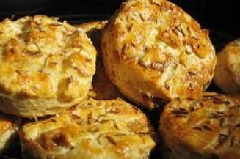 A
type of biscuit made from flour, potatoes and lard (sometimes pork crackling - Grammel),
called "Pogasa" or "Pogatscherl" in Hungarian, would keep for days and could be carried to the
fields or on journeys. These are still very popular among the descendants of the immigrants of
the Lehigh Valley of Pennsylvania. It's interesting that the name of these biscuits has been
corrupted in countless ways. I've heard dozens, everything from "Bogotchel" to "Gramelgasa" to
Potato Biscuits! I recently was served one in an ethnic restaurant in Coplay, PA. It cost
$1.25 per portion and was made with shortening instead of lard, but still tasty. They were
also frequently eaten with wine. A
type of biscuit made from flour, potatoes and lard (sometimes pork crackling - Grammel),
called "Pogasa" or "Pogatscherl" in Hungarian, would keep for days and could be carried to the
fields or on journeys. These are still very popular among the descendants of the immigrants of
the Lehigh Valley of Pennsylvania. It's interesting that the name of these biscuits has been
corrupted in countless ways. I've heard dozens, everything from "Bogotchel" to "Gramelgasa" to
Potato Biscuits! I recently was served one in an ethnic restaurant in Coplay, PA. It cost
$1.25 per portion and was made with shortening instead of lard, but still tasty. They were
also frequently eaten with wine.Donuts, "Fastnachts or "Krapfen", filled with jelly or unfilled, sprinkled with sugar were very popular holiday items, especially before the start of Lent. "Kipfels", a crescent shaped cookie (celebrating victory over the Turks, hence the crescent shape) or pastry made from sweetened raised or cottage cheese dough and filled with ground nuts and sugar or prune butter (Lekvar) or preserves were another holiday treat. Oranges were only seen at Christmas. Imported food was for the nobility or those who were wealthy. Marzipan, candy made from sugar and ground almonds, colored and made in the shape of nuts, fruits and flowers were a Christmas treat as were gold and silver painted walnuts. Salt, tobacco and candles were a government monopoly. Contracts (a franchise) were sold to merchants allowing them exclusive rights to deal in these goods. High prices resulted. Lamp oil was also expensive. In the same way, the price the small holder received for farm products was regulated by tariffs. He got it going and coming! This just scratches the surface of ethnic Burgenland food. If interested further, Austrian or Hungarian cookbooks will approximate some of this "peasant" or "kitchen" food. Burgenländers, like the Viennese, borrowed the best of German, Hungarian and Croatian cuisine along with some ideas from the Turks. Local Burgenland cookbooks, in German and using metric measurements are available. The problem with cookbooks, however, is that they tend to romanticize and embellish the Burgenland peasant gustatory experience. For instance they invariably call for butter or shortening or some imported spice or ingredient which was unavailable or prohibitively expensive and who today would suggest the use of lard? The BG newsletter contains a good recipe column in English. They sell the cookbook from which these recipes are taken. You probably remember your own favorite ethnic dishes and probably still cook variations of them. Some of the plain kitchen food is dying out, as the Burgenland lifestyle becomes more like ours, as are the cooks who know how to prepare it. More and more world-class food is appearing in Burgenland restaurants and homes, but a Gasthaus will often offer some ethnic food on the pension menu or as a "regional specialty", particularly strudels. A first class hotel we enjoyed in Baden (Austria) one day had plum dumplings on the pension menu. I hadn't purchased a room with pension meals and I had to get very aggressive to be served a portion! We also had a great potato strudel with Grammel and sauerkraut in a Gasthaus in Graz, as well as a fine creamed pumpkin soup. The small holder's life was constantly involved with food. The planting, raising and harvesting of it, the feeding, care and butchering of animals, laboring in the vineyards, carrying wheat and rye to the miller, turning cabbage into sauerkraut, grapes to wine, meat to sausage and fruit to cider, preserves and schnapps. In addition they had the most difficult task of deciding how much to sell (the Burgenland was always Vienna's garden) for much needed cash for taxes, 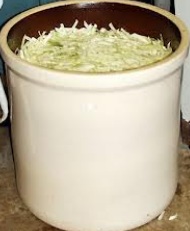 clothing and necessities and how much to keep. A bad decision could be disastrous. Hard to
visualize in our day of salaries and supermarket abundance. This involvement with food was a
tradition that emigrants to America found hard to break. It wasn't until they became old and
feeble that my grandparents gave up this personal involvement with food in favor of the
supermarket. I still remember their grape arbor, the "back yard" kitchen garden, the wine
barrels and "Schnapps" still in the cellar, sauerkraut crocks and all kinds of canning and
live fowl. This didn't stop them from daily trips to the butcher, patronizing the local
produce hucksters or visiting the farmers' market, most of which would have been impossible in
the Burgenland.
clothing and necessities and how much to keep. A bad decision could be disastrous. Hard to
visualize in our day of salaries and supermarket abundance. This involvement with food was a
tradition that emigrants to America found hard to break. It wasn't until they became old and
feeble that my grandparents gave up this personal involvement with food in favor of the
supermarket. I still remember their grape arbor, the "back yard" kitchen garden, the wine
barrels and "Schnapps" still in the cellar, sauerkraut crocks and all kinds of canning and
live fowl. This didn't stop them from daily trips to the butcher, patronizing the local
produce hucksters or visiting the farmers' market, most of which would have been impossible in
the Burgenland.I'll close with an old Burgenland prayer of Grace found in the Mühlgrabner cookbook (with apologies for the literal translation): Tischgebet (prayer at mealtime) Jedes Tierlein hat sein fressen, (Every small animal has its feed) jedes Blumlein trinkt von dir- (every small flower drinks from you) hast auch meiner nicht vergessen, (you also have remembered my need) lieber Gott, ich danke Dir! (dear God, I thank you) This article was slanted toward small-holder families. It does not cover what would have been the diet norm for wealthier families. This can be found in publications like Gourmet's Old Vienna Cookbook. It would be interesting to compare the two extremes. If someone has memories on which to base such an article, I'd be most happy to publish it. Sources: - The personal kitchen cook books of the Burgenland emigrant Sorger family - Various issues of the Burgenländische Gemeinschaft newsletter - Mühlgrabner Koch und Backrezepte, 1996, Gröbnerdruck, Oberwart - Grossman's Guide to Wines, Spirits and Beers, 1974, Scribners & Sons, NY - Gourmet's Old Vienna Cookbook, L. L. Christensen, 1959, Gourmet Books, Inc. - The Cuisine of Hungary, Lang, 1971, Bonanza Books - All Along the Danube, Polvay, 1979, Prentice Hall - The Paprikas Weiss Hungarian Cookbook, Weiss & Buchan, 1983, Crown Publishers - The Cooking of Vienna's Empire, Wechsberg, 1968, Time-Life Books - The Habsburg Monarchy as a Customs Union, Komlos, 1983, Princeton Univ. Press |
| 7) ETHNIC EVENTS LEHIGH VALLEY, PA (courtesy of Bob Strauch) Saturday, March 2: Bockbier-Fest at the Reading Liederkranz. Music by the Mountain Tops. Info. www.readingliederkranz.com Sunday, March 3: Schlachtfest at Holy Family Club in Nazareth. Info: www.holyfamilyclub.com Sunday, March 3: Evening of Song with choruses of the United German Singers of Philadelphia at the Cannstatter Volksfest-Verein in Philadelphia. Info: www.cvvphilly.com LANCASTER, PA Saturday, March 2, 5:30 to 7:30 pm: First Tuesday Buffet (Members $10 - Guests $14). Lancaster Liederkranz. Entertainment by Carl Heidlauf. Saturday, March 9, 7:30 to 11:30 pm: Bockbier Fest (Members $8 - Guests $10). Lancaster Liederkranz. Music by Heidi und Heimat Echo. Dinner service available 5:30 to 8 pm. Sunday, March 17, 12:00 to 5:30 pm: Cabbage Hill Day (Adults $10 - Children 3-11 $4). Lancaster Liederkranz. Music by Die Immergrün Musikanten. Pork & Sauerkraut served 12:30 to 2:00 pm. LLK Chorus, Schuhplattler Dancers, Kindergruppe, Hobby Chor & Alleweil Jung during band breaks. NEW BRITAIN, CT Friday, March 1, 7 pm: Heimat Abend. Austrian Donau Club, 545 Arch Street, New Britain, CT (860 223-9401). Music by Joe Rogers. Friday, March 15, 7 pm: Heurigan Abend. Austrian Donau Club. Music by Schachtelgebirger Musikanten. Friday, March 29, 6 pm: Good Friday Fresh Fish Fry scholarship fundraising dinner. Austrian Donau Club. Dinner includes fresh fried fish, fresh coleslaw and potatoes for a donation of $12. Advanced Tickets only; call 860-759-9721. |
8) BURGENLAND EMIGRANT OBITUARIES (courtesy of Bob Strauch) Pauline Deutsch  Pauline
Deutsch (née Lipovits), 94, of Brick, New Jersey, formerly of Clifton, passed away on January
31, 2013. Pauline
Deutsch (née Lipovits), 94, of Brick, New Jersey, formerly of Clifton, passed away on January
31, 2013.Born in Allentown, Pennsylvania, Mrs. Deutsch was raised in Gaas, Burgenland, Austria and returned to the United States as a young woman, living in Clifton before moving to Brick in 2008. Prior to retiring, she had been employed with Forstmann Woolen Mills, Shulton Inc., formerly in Clifton and lastly Blackalloy in Paterson. She was a parishioner of Holy Trinity R.C. Church, Passaic where she was a member of the Kolping Society and the Ladies Society, of which she was a Past Officer. Mrs. Deutsch was predeceased by her husband, Julius; by two grandchildren, Judith and Daniel Deutsch; one great-grandson, Nicholas Deutsch; two sisters, Anna Csencsits and her husband Joseph, Marie Paukovits and her husband Stefan; her brother, Joseph Lipovits; and by her brother-in-law, Karl Trippel. Survivors include: her son, Bert Deutsch and his wife, Kathleen, of Manahawkin; her daughter, Tina Pasco and her husband, William, of Brick; her sister, Christl Trippel of Gaas, Austria; sister-in-law, Ella Lipovits; grandson, Bert Deutsch and his wife Suzanne; great-grandsons Dylan and Michael Deutsch; step-grandchildren: William and his wife Lois, Mark and his wife Karen, James and Nancy; step-great-grandchildren: James, William, Dylan and Joseph; and numerous nieces and nephews. Funeral services will be Tuesday 9:15 AM from the Bizub-Quinlan Funeral Home, 1313 Van Houten Avenue, Clifton and 10 AM at Holy Trinity R.C. Church, cor. Hope Avenue and Harrison Street, Passaic. Entombment Calvary Cemetery Mausoleum, Paterson. Visiting Monday from 3-7 PM. In lieu of flowers, memorial contributions may be made to Holy Trinity R.C. Church, 226 Harrison St., Passaic, NJ 07055 or Alzheimer's Association, 400 Morris Avenue, Suite 251, Denville, NJ 07834. Please visit www.bizub.com for driving directions and online condolences. Published in The Record/Herald News on February 2, 2013 Johanna Miller Knaus  Johanna
Miller Knaus (née Poglitsch), of Southington, Connecticut, passed away on Feb. 5, 2012 at
Southington Care Center surrounded by her loving family. Johanna
Miller Knaus (née Poglitsch), of Southington, Connecticut, passed away on Feb. 5, 2012 at
Southington Care Center surrounded by her loving family.She was previously a resident of New Britain and Newington before moving to Southington ten years ago. She was the widow of Frank R. Miller, Sr. and John F. Knaus, Sr. She was born in New Britain to the late Karl and Johanna (Prem) Poglitsch and moved to Tauka, Austria until the age of 15. Johanna was formerly employed at Fafnir Bearing as an office clerk. She was a devoted member of St. John's Evangelical Lutheran Church where she taught Sunday School, was a member of the Altar Guild and served as an office volunteer. Surviving are two sons, Frank R. Miller and his wife Marilyn of Southington and Alan R. Miller of Vero Beach, Fla.; two sisters, Helen Terwilliger and Eleanor Bujdos; a step-son, Robert Knaus and his wife Janet; her step daughter in law, Barbara Knaus; her grandchildren, Laura Webster, John Miller, Beth Moller, Lisa Doucette, Linda Drago, Carole Capodiece, Patti Byrnes, Robin Bruno, Peter Knaus, and Jeffrey Knaus; twenty three great-grandchildren; several great great-grandchildren; and many nieces and nephews. Johanna was predeceased by her step-son, John F. "Jack" Knaus, Jr., and six brothers and sisters, Stephanie Wacker, Emma Halloran, Margaret Woodstock, Carl, Herman, and Edward Poglitsch. Funeral services will be held on Monday at 11 a.m. at St. John's Evangelical Lutheran Church. Burial will be in Fairview Cemetery. Calling hours are Sunday from 4-7 p.m. at Erickson-Hansen Funeral Home, 411 So. Main St., New Britain. Memorial donations may be made to St. John's Evangelical Lutheran Church, 295 Arch St., New Britain, CT 06051, or to Southington Care Center, 45 Meriden Ave., Southington, CT 06489. Please share a memory of Johanna with the family in the on line guest book at www.ericksonhansen.com Published in The Hartford Courant on February 8, 2013 Maria Woppel  Maria
Woppel 86, of Sparta, New Jersey, died Thursday, Feb. 7, 2013, at Barn Hill Care Center in
Newton. Maria
Woppel 86, of Sparta, New Jersey, died Thursday, Feb. 7, 2013, at Barn Hill Care Center in
Newton.Born in Woppendorf, Austria, on Oct. 31, 1926, she was a daughter of the late Karl and Gisela (Gossy) Woppel. She had resided in Wayne moving to Franklin in 1993, where she lived before becoming a resident of Bentley Assisted Living in Branchville. For the past month, Mrs. Woppel had resided at Knoll View in Sparta. Mrs. Woppel was a seamstress working for H & T. Sportswear of West Paterson and E & M Cloth Co. of Paterson. She retired in 1991 after 38 years in the garment industry. She was a member of ILGWU Local 134 since 1947. Mrs. Woppel was a parishioner of Immaculate Conception R.C. Church in Franklin and a member of the Franklin Senior Citizens. She is survived by her sons, Richard Maier Jr. of Vernon and Eric Maier of Wantage, as well as three grandchildren, Dana, Eric and Matthew. Funeral services will be held Tuesday, Feb. 12, at 9:30 a.m. from F. John Ramsey Funeral Home, One Main St., Franklin, to Immaculate Conception R.C. Church, Franklin, for a 10 a.m. Mass of Christian Burial. Entombment will follow at Immaculate Conception Cemetery, Mausoleum. Friends may call at the funeral home Monday, Feb. 11, from 2 to 4 and 7 to 9 p.m. In lieu of flowers, memorial donations may be made to Immaculate Conception R.C. Church, 75 Church St., Franklin, NJ 07416. For directions and condolences, please see www.fjohnramseyfuneralhome.com. Published in The New Jersey Herald on February 10, 2013 Fredrick Schoeck  Fredrick
Schoeck, 94, of Westvale, New York, passed away on Thursday, February 14, 2013. Fredrick
Schoeck, 94, of Westvale, New York, passed away on Thursday, February 14, 2013.Fredrick was born in Grosspetersdorf, Austria and resided in the Syracuse area for most of his life. He worked as a mason for many years with Schoeck Builders and retired in 1984 from the Carrier Corp., after 20 years of service. Fredrick was a member of St. Stephen Lutheran Church where he served as an usher and greeter. He was also a member of the Arion Singing Society. He raised Award-winning Pygmy Pouter Pigeons and was proud of his beautiful lilac bushes. Survivors include his wife of 70 years, Ingetraude; his daughters, Pauline (Michael) DeMartino and Irene Woolson; his sons, Frederick (Doreen) and Donald; his 11 grandchildren; 24 great-grandchildren and his great-great-grandson. His grandson, Philip Woolson predeceased him in 1991. Calling hours will be Monday from 11 a.m. to noon at Carter Funeral Home, 1604 Grant Blvd., Syracuse and prayer services will be at noon at the funeral home. Burial will follow in Woodlawn Cemetery. Online condolences maybe expressed at CarterFuneralHome.com Published in Syracuse Post Standard from February 15 to February 17, 2013 Cecelia Sauer  Cecelia
Sauer, 91, of Bethlehem, Pennsylvania, passed away on Monday, February 18, 2013 at Lehigh
Valley Hospital-Muhlenberg with her family at her bedside. Cecelia
Sauer, 91, of Bethlehem, Pennsylvania, passed away on Monday, February 18, 2013 at Lehigh
Valley Hospital-Muhlenberg with her family at her bedside. She was the wife of the late Joseph M. Sauer. Born in Tschanigraben, Austria, to the late Franz and Cecelia (Keppel) Yost, she came to the United States at age seven and was a lifelong resident of Bethlehem. She was employed by Moravian College and the Laros Company. Cecelia was a member of Our Lady of Perpetual Help Catholic Church, Bethlehem Township, where she and Joseph were charter members. She enjoyed entertaining family and friends and was a wonderful cook. Her Christmas cookies and Kipfels were family favorites. Happy times around her table have not been forgotten. Cecelia was also an accomplished seamstress and quilter. Survivors: Cecelia will be lovingly remembered by her sons, Joseph F. Sauer and his wife, Diann, Dr. Thomas Sauer and his wife, Linda; and daughter, Joan Wilvert and her husband, Gregg, all of Bethlehem; six grandchildren and seven great-grandchildren. Services: A Mass of Christian Burial will be held on Friday, February 22, 2013 at 11 a.m. at Our Lady of Perpetual Help Catholic Church, 3219 Santee Rd., Bethlehem, PA 18020 with a viewing from 10 to 11 a.m. in the church. There will be an evening visitation on Thursday, from 7 to 9 p.m. at Connell Funeral Home, Inc., 245 E. Broad St., Bethlehem. Send online condolences to: www.connellfuneral.com. Contributions: Memorial contributions may be made to the church. |
END OF NEWSLETTER |
NOTICE (Terms and Conditions): The Burgenland Bunch (BB) was formed and exists to assist Burgenland descendants in their research into their heritage and, toward that end, reserves the right to use any communication you have with us (email, letter, phone conversation, etc.) as part of our information exchange and educational research efforts. • If you do not want your communication to be used for this purpose, indicate that it is "confidential" and we will abide by that request. • Correspondents who communicate with the BB without requesting confidentiality retain their copyright but give a non-exclusive license to the BB allowing us to forward to BB members, publish in our monthly newsletter or on our website, and/or subsequently and permanently archive all or parts of such communications. The Burgenland Bunch homepage (website) can be found at: http://www.the-burgenland-bunch.org/ Burgenland Bunch Newsletter, copyright © 2013 by The Burgenland Bunch All rights reserved. Permission to copy excerpts granted if credit is provided. |
 News
News I
received my first letter from him in February 1963—I still have the letter—and we continued to
write letters. All together 240 letters. I saved them. He visited me in 1965, during my Easter
holidays, and stayed for 13 days. I was so in love and, I suppose, so was he, because the
texture of our letters changed somewhat. But we made a deal: not to keep writing love letters
but to continue to share our lives, ideas and daily events.
I
received my first letter from him in February 1963—I still have the letter—and we continued to
write letters. All together 240 letters. I saved them. He visited me in 1965, during my Easter
holidays, and stayed for 13 days. I was so in love and, I suppose, so was he, because the
texture of our letters changed somewhat. But we made a deal: not to keep writing love letters
but to continue to share our lives, ideas and daily events.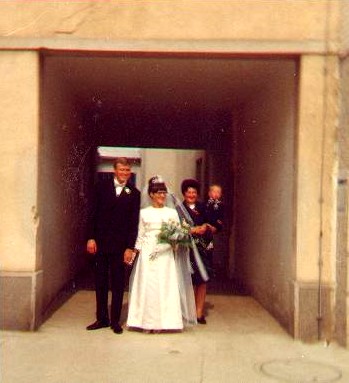 My
parents insisted on reading that specific letter. The response to it was that Herbert called
me by telephone and said he would come and we would get married in July 1968.
My
parents insisted on reading that specific letter. The response to it was that Herbert called
me by telephone and said he would come and we would get married in July 1968.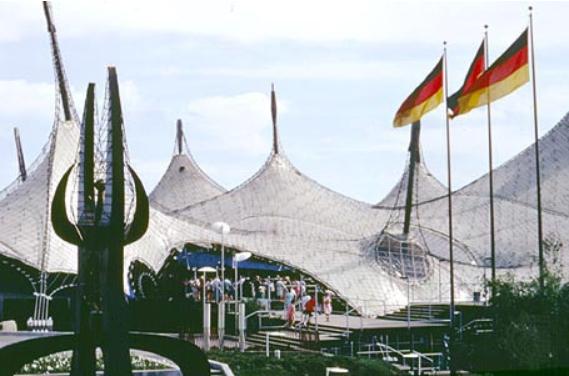 Then
I needed to get a lung x-ray for tuberculosis and only then I was allowed to immigrate on my
own merit.
Then
I needed to get a lung x-ray for tuberculosis and only then I was allowed to immigrate on my
own merit.